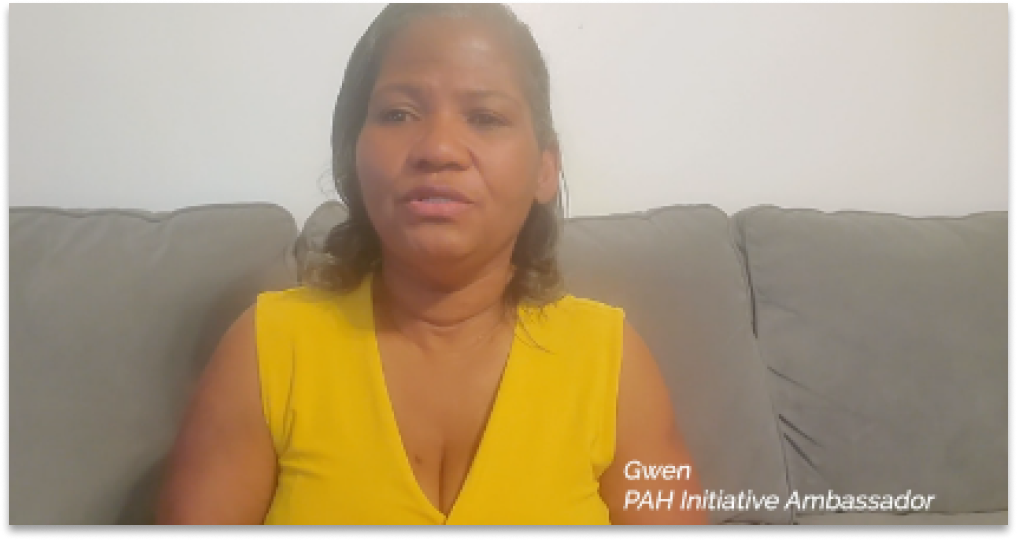
People living with PAH can appreciate that what seems simple for some isn’t so simple for others. Take breathing—we’ve all done it since being born, and yet we all know it’s not so easy for people with PAH. So what role does oxygen play in PAH? Why do PAH patients sometimes need more oxygen than their bodies can take in on their own?
When we breathe in air, the lungs absorb oxygen and distribute it throughout the body through the bloodstream to organs, tissues, and cells to make energy.
But when someone is diagnosed with PAH, their lungs—and therefore, the rest of the body—struggle to get enough oxygen because of narrowed blood vessels in the lungs. When the body doesn’t have enough oxygen, it affects how your body functions and the way you feel. You may feel fatigue, fuzzy-headed, or shortness of breath as a result.
For those who have certain medical conditions that cause low blood oxygen, such as PAH, oxygen therapy may be recommended by a healthcare professional.
Oxygen therapy, sometimes called supplemental oxygen, gives the body more oxygen with each inward breath, reducing symptoms like shortness of breath.
To determine whether you’re getting enough oxygen, your doctor may measure the oxygen level of blood through a test called pulse oximetry or a blood test. You’ve probably had a pulse oximetry test before with a clip-like device on your finger. The probe uses light to measure how much oxygen is in the blood.
Because PAH could limit the amount of oxygen available to your body, oxygen therapies can help ensure your body is getting enough oxygen. Some people may need oxygen 24/7, while others may need it only in special circumstances such as when traveling in an airplane.
Your physician may prescribe oxygen as a supplemental therapy in addition to your current PAH treatments. While oxygen therapy does not treat PAH itself and is not a replacement for PAH medications, it can help decrease PAH symptoms like fatigue, improve oxygen saturation in the blood, and reduce hospital readmissions.
When you’re given oxygen therapy, there are several ways it may be administered.
The most commonly used type of oxygen equipment for those on long-term oxygen therapy is called standard oxygen concentrators, which take in air and filter out things besides oxygen. Standard oxygen concentrators are about 50 lb, often on wheels, and they’re safer than compressed gas cylinders. Oxygen concentrators usually run on electricity.
The oxygen delivery system used by most patients is a nasal cannula, a small plastic tube with nasal prongs, which makes it more convenient to receive oxygen while going about the day.
Portable oxygen concentrators are also common for those on long-term oxygen therapy. Because they run on a battery (some models can even be charged in the car) and are under 20 lb, they are ideal for those who regularly go outside.
Compressed oxygen gas tanks are also used by many PAH patients, but the tanks can be quite heavy depending on the size. These can only be used on commercial aircraft if they are supplied by the airline.
Liquid oxygen systems are also an option for some people, although they can be expensive and difficult to obtain. The portable units are lightweight, with a small reservoir containing liquid oxygen that must be refilled from larger, at-home reservoirs periodically. While the portable units do not require a battery or power source, liquid oxygen is classified by the Federal Aviation Administration (FAA) as hazardous material and cannot be taken on commercial flights.
Talk to your doctor if you think you are experiencing any symptoms from lack of oxygen and to determine whether you may need oxygen and how often you would need it.
There are many different types of oxygen equipment available today. To get the most out of oxygen therapy, it’s important to choose a therapy that works best for you.
Speak with your healthcare provider to determine how much oxygen you need. When talking to your healthcare team, consider your personal goals and ask what your doctor’s clinical goals are for you.
Next, think about your lifestyle. How often do you leave the house? What are your hobbies? How active are you? If you’re often on the go, then maybe you’ll need something lighter for mobility.
And finally, ask yourself which types of equipment you’re capable of handling. How heavy is your desired machine and how much can you lift on your own? What is your dexterity like? What is your comfort level? If you have specific preferences for a type of oxygen system, let your doctor know so they can help recommend the right oxygen therapy for you.
Talk to your healthcare provider to get more details about the types of equipment you’re interested in.
Keep reading to learn more about oxygen and everyday living with PAH.
PAH is a complicated disease that can be difficult to understand. We’ve broken it down for you with easy-to-understand information, simple graphics, and informative videos from a PAH specialist.
What is PAH?
Learn how Peggy renewed her competitive spirit after her PAH diagnosis and how she won't let an oxygen tank define her.
Competitive Spirit with PAH ⟩
How has knowing their risk status helped Lauren and Karen better understand if their treatment plan is working?
Knowing your PAH Risk Status ⟩
Living with PAH can be a big adjustment and taking care of yourself can make a big difference. But where do you start?
Self-Care and Healthy Living ⟩